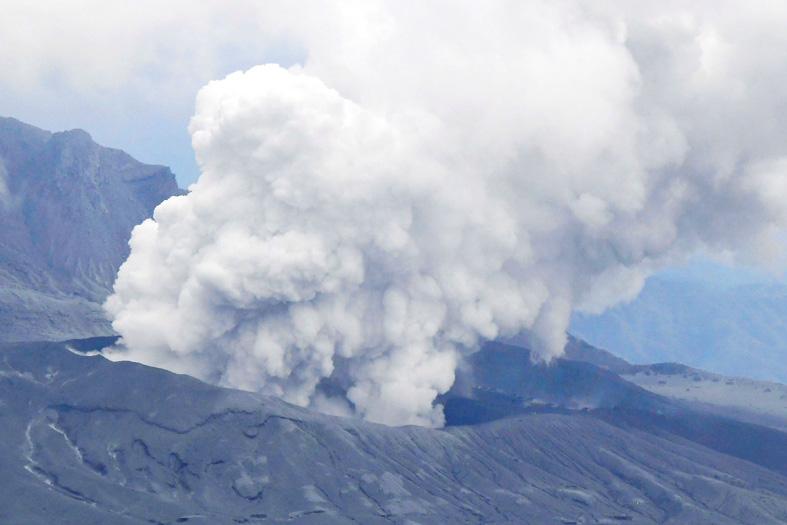Japan’s Mount Aso erupted yesterday, spewing a giant column of ash thousands of meters into the sky as hikers rushed away from the popular tourist spot.
No injuries were immediately reported after the late-morning eruption in southwest Japan, which sent rocks flying in a dramatic blast captured by nearby CCTV cameras.
People were warned not to approach the volcano as it ejected hot gas and ash as high as 3,500m, and sent stones tumbling down its grassy slopes.

Photo: Kyodo / via Reuters
Authorities were checking if any hikers had been trapped or injured, officials told local media, as TV footage showed dozens of vehicles and tour buses parked at a nearby museum that has a clear view of the volcano.
Pale gray torrents of ash were seen rushing down Aso’s slopes toward the museum, but did not reach the site.
For those near the mountain, “caution must be exercised for large flying rocks and flows of pyroclastic materials,” Japan Meteorological Agency (JMA) official Tomoaki Ozaki said.
“Caution is warranted even in far-away areas downwind, as the wind may carry not just ash, but also pebbles,” Ozaki told a televised news conference, warning that toxic gases might also have been emitted.
The last time the JMA raised its warning for Aso to yesterday’s level — three out of five — was when it erupted in 2016, having rumbled to life the previous year after being dormant for 19 years.
The agency has been warning of increasing volcanic activity there in the past few days, including a small eruption on Thursday last week.
Mount Aso’s huge caldera dominates the southwestern main island of Kyushu, where the 1,592m volcano is a popular tourist draw.
Japan is one of the world’s most volcanically active countries.
It sits on the so-called Pacific “Ring of Fire” where a large proportion of the planet’s quakes and volcanic eruptions are recorded.
In September 2014, Japan experienced its deadliest eruption in almost 90 years when Mount Ontake, in central Nagano Prefecture, burst unexpectedly to life, killing an estimated 63 people.

BOMBARDMENT: Moscow sent more than 440 drones and 32 missiles, Volodymyr Zelenskiy said, in ‘one of the most terrifying strikes’ on the capital in recent months A nighttime Russian missile and drone bombardment of Ukraine killed at least 15 people and injured 116 while they slept in their homes, local officials said yesterday, with the main barrage centering on the capital, Kyiv. Kyiv City Military Administration head Tymur Tkachenko said 14 people were killed and 99 were injured as explosions echoed across the city for hours during the night. The bombardment demolished a nine-story residential building, destroying dozens of apartments. Emergency workers were at the scene to rescue people from under the rubble. Russia flung more than 440 drones and 32 missiles at Ukraine, Ukrainian President Volodymyr Zelenskiy

COMPETITION: The US and Russia make up about 90 percent of the world stockpile and are adding new versions, while China’s nuclear force is steadily rising, SIPRI said Most of the world’s nuclear-armed states continued to modernize their arsenals last year, setting the stage for a new nuclear arms race, the Stockholm International Peace Research Institute (SIPRI) said yesterday. Nuclear powers including the US and Russia — which account for about 90 percent of the world’s stockpile — had spent time last year “upgrading existing weapons and adding newer versions,” researchers said. Since the end of the Cold War, old warheads have generally been dismantled quicker than new ones have been deployed, resulting in a decrease in the overall number of warheads. However, SIPRI said that the trend was likely

‘SHORTSIGHTED’: Using aid as leverage is punitive, would not be regarded well among Pacific Island nations and would further open the door for China, an academic said New Zealand has suspended millions of dollars in budget funding to the Cook Islands, it said yesterday, as the relationship between the two constitutionally linked countries continues to deteriorate amid the island group’s deepening ties with China. A spokesperson for New Zealand Minister of Foreign Affairs Winston Peters said in a statement that New Zealand early this month decided to suspend payment of NZ$18.2 million (US$11 million) in core sector support funding for this year and next year as it “relies on a high trust bilateral relationship.” New Zealand and Australia have become increasingly cautious about China’s growing presence in the Pacific

Indonesia’s Mount Lewotobi Laki-Laki yesterday erupted again with giant ash and smoke plumes after forcing evacuations of villages and flight cancelations, including to and from the resort island of Bali. Several eruptions sent ash up to 5km into the sky on Tuesday evening to yesterday afternoon. An eruption on Tuesday afternoon sent thick, gray clouds 10km into the sky that expanded into a mushroom-shaped ash cloud visible as much as 150km kilometers away. The eruption alert was raised on Tuesday to the highest level and the danger zone where people are recommended to leave was expanded to 8km from the crater. Officers also